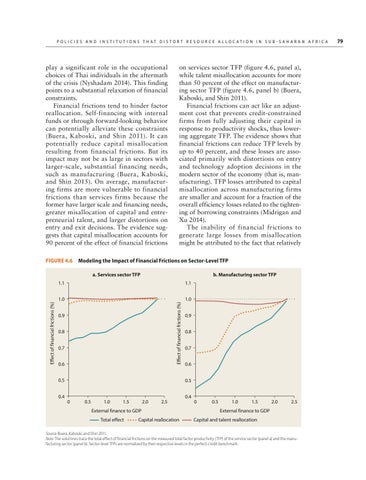P o l i c i e s a n d I n s t i t u t i o n s t h a t D i s t o r t R e s o u r c e A ll o ca t i o n i n S u b - Sa h a r a n A f r i ca
play a significant role in the occupational choices of Thai individuals in the aftermath of the crisis (Nyshadam 2014). This finding points to a substantial relaxation of financial constraints. Financial frictions tend to hinder factor reallocation. Self-financing with internal funds or through forward-looking behavior can potentially alleviate these constraints (Buera, Kaboski, and Shin 2011). It can potentially reduce capital misallocation resulting from financial frictions. But its impact may not be as large in sectors with larger-scale, substantial financing needs, such as manufacturing (Buera, Kaboski, and Shin 2015). On average, manufacturing firms are more vulnerable to financial frictions than services firms because the former have larger scale and financing needs, greater misallocation of capital and entrepreneurial talent, and larger distortions on entry and exit decisions. The evidence suggests that capital misallocation accounts for 90 percent of the effect of financial frictions
on services sector TFP (figure 4.6, panel a), while talent misallocation accounts for more than 50 percent of the effect on manufacturing sector TFP (figure 4.6, panel b) (Buera, Kaboski, and Shin 2011). Financial frictions can act like an adjustment cost that prevents credit-constrained firms from fully adjusting their capital in response to productivity shocks, thus lowering aggregate TFP. The evidence shows that financial frictions can reduce TFP levels by up to 40 percent, and these losses are associated primarily with distortions on entry and technology adoption decisions in the modern sector of the economy (that is, manufacturing). TFP losses attributed to capital misallocation across manufacturing firms are smaller and account for a fraction of the overall efficiency losses related to the tightening of borrowing constraints (Midrigan and Xu 2014). The inability of financial frictions to generate large losses from misallocation might be attributed to the fact that relatively
FIGURE 4.6 Modeling the Impact of Financial Frictions on Sector-Level TFP b. Manufacturing sector TFP
1.1
1.1
1.0
1.0
Effect of financial frictions (%)
Effect of financial frictions (%)
a. Services sector TFP
0.9 0.8 0.7 0.6 0.5 0.4
0.9 0.8 0.7 0.6 0.5
0
0.5
1.0
1.5
2.0
2.5
External finance to GDP Total effect
Capital reallocation
0.4
0
0.5
1.0
1.5
2.0
2.5
External finance to GDP Capital and talent reallocation
Source: Buera, Kaboski, and Shin 2011. Note: The solid lines trace the total effect of financial frictions on the measured total factor productivity (TFP) of the service sector (panel a) and the manufacturing sector (panel b). Sector-level TFPs are normalized by their respective levels in the perfect-credit benchmark.
79



